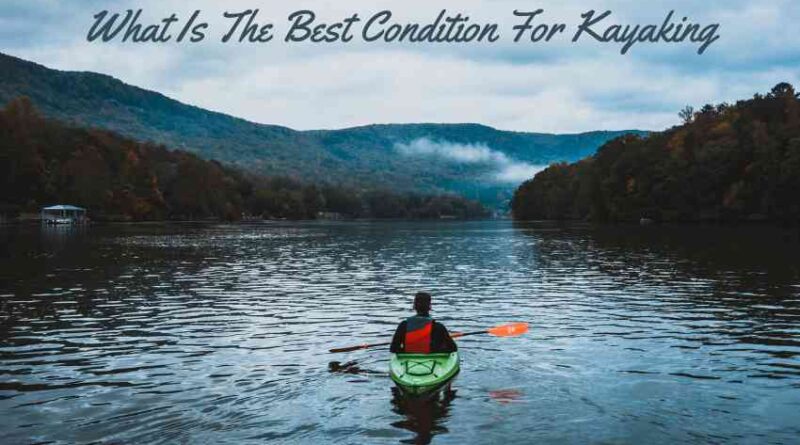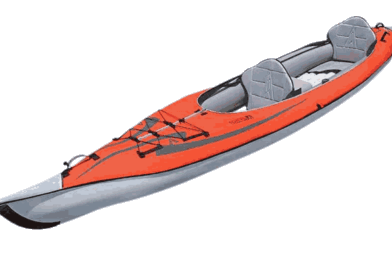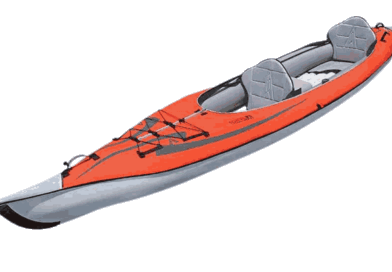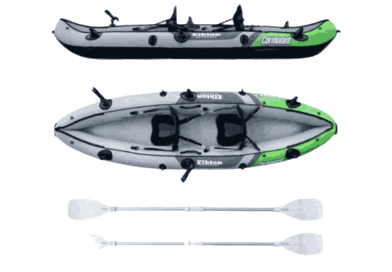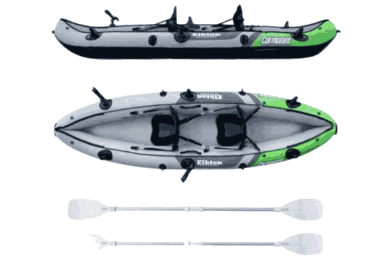What Is The Best Condition For Kayaking? Learn More
What Is The Best Condition For Kayaking? - We Answered the Top Inquiries with Finesse!
Are you looking for an exciting outdoor activity that combines adventure, exercise, and relaxation?
Whether you’re a seasoned pro or a newbie, kayaking can be an incredibly rewarding experience.
But what are the best conditions for kayaking, and how do they vary for fishing kayaking?
In this article, we’ll cover everything you need to know to make the most of your kayaking adventures, no matter what your skill level or goals may be. So grab your paddle, put on your life jacket, and let’s dive in!
What Is The Best Condition For Kayaking?
Before going kayaking, it’s important to check the weather. According to the American Canoe Association, look for sunny days with calm winds and water temperatures above 70 degrees Fahrenheit for the best experience. Checking the weather forecast helps you avoid unexpected storms or strong currents.
Remember, what may feel warm on land may be chilly on the water, so dress accordingly. Good weather conditions make kayaking fun and safe.
Table of Contents
What Is The Best Posture For Kayaking?
When kayaking, sit up straight with your head held high and lean forward a little from your hips. Pretend there’s a string pulling your back straight.
Put the paddle in the water near your toes and keep the shaft upright. Don’t lean too much or move your body too much, just reach with your arms. This is the best posture for kayaking!
What Muscles Are Best For Kayaking?
Kayaking uses many muscles in the body, but some are more important than others. The most essential muscles for kayaking are the back, shoulders, arms, core, and legs.
These muscles help you paddle efficiently, maintain good posture, and stay stable on choppy water. By working on these muscles, you can be faster and have more control when kayaking.
Now that we know which muscles are crucial for optimal kayaking performance let’s explore how this activity can benefit our bodies even further by discussing what other specific muscles it targets.
What Muscles Is Kayaking Good For?
Kayaking is like being a conductor of your own body. It’s a fun workout that makes your muscles stronger and helps you feel balanced. It’s especially good for your lower back, arms, shoulders, chest, and core.
Kayaking also helps with your posture and flexibility. So if you want a refreshing and challenging full-body workout, kayaking is a great choice!
As exhilarating as kayaking can be, it’s important to note that certain weather conditions may affect its suitability.
Next up we’ll explore what temperature range is recommended for this activity so you can enjoy the waters safely!
What Temperature Range Is Ok For Kayaking?
According to the American Canoe Association, the best temperature for kayaking is 60°F and up, so you can wear light clothes. If the water is colder than 60°F, you need to be more careful. Between 45-54°F, you should wear a drysuit to avoid getting too cold. If the water is colder than 45°F, you must wear a drysuit to stay safe.
It’s important to follow these guidelines to keep yourself warm and have fun while kayaking. (Source: American Canoe Association, “Cold Water Survival” and “Heat Illness Prevention” guidelines.)
How Wet Is Kayaking?
Kayaking is fun, but it’s better to do it when the weather is good. You’ll get wet when you kayak, so make sure you wear the right clothes and bring waterproof stuff.
Some people like rough water, but others prefer calm water. Kayaking is a good way to feel close to nature and challenge yourself.
In the next section, we’ll explore what is considered the top speed for kayaking and what factors come into play when trying to reach it.
What Is The Top Speed For Kayaking?
Kayaking speed depends on 4 things: your skill, fitness, weather, and water current. Safety is most important, so don’t go too fast and be careful!
Next, let’s talk about if you get wet while kayaking.
Do We Get Wet In Kayaking?
Yes, you will get wet while kayaking. But it’s part of the fun! You may get splashed on your hands and arms. You need to wear special gear for safety.
The gear you need depends on the weather and water temperature. For example, wear a life jacket when it’s sunny and warm, and a wetsuit when it’s rainy and chilly. Kayaking is a great way to enjoy nature, but make sure to stay safe!
So now that we know getting wet is inevitable in kayaking let us move forward with another important aspect – Can everyone do Kayaking?
Can Everyone Do Kayaking?
Kayaking is possible for most people, but you need to be physically fit, have good balance and coordination, and be comfortable in the water.
If you have any health concerns, it’s important to consider these before kayaking. Don’t worry though, if you’re unsure about your abilities, ask an expert for help.
In the next section, we’ll explore what skills are needed for kayaking so that you can feel confident hitting the water on your own.
What Skills Are Needed For Kayaking?
Kayaking is a fun water sport, but you need to learn some skills first. You have to know how to paddle and steer the kayak, and where you can go with it.
You need to be safe and have the right equipment like a life jacket and first aid kit. You also need to practice rotating your torso when paddling.
So can a beginner do kayaking? Absolutely!
Can A Beginner Do Kayaking?
Kayaking is a sport that needs some strength and skill, but it’s easy for beginners. Start in calm waters to learn how to paddle and steer. You can go to more challenging places when you’re comfortable.
Kayaking is good for your body and mind. It makes your arm and chest muscles stronger and helps your heart. It’s also peaceful and relaxing, which helps you feel less stressed.
We have compiled a selection of 12 outstanding fishing kayaks that have been extensively tested and evaluated, demonstrating exceptional performance. You may want to review them as well.
As we move on from discussing whether beginners can do kayaking, let’s explore just how healthy this activity really is.
How Healthy Is Kayaking?
According to a study published in the International Journal of Environmental Research and Public Health, kayaking helps make your heart and muscles stronger, improves your balance and coordination, and keeps you healthy by preventing diseases like heart disease and diabetes. Kayaking is a great way to exercise while enjoying nature.
If you’re looking for a fun and healthy activity, try kayaking!
How Do I Increase My Stamina For Kayaking?
Kayaking requires strength and endurance. To get better at it, do exercises like cycling, running, and swimming. These exercises build up your heart and lung strength, which helps you paddle for longer periods.
Start slow, then gradually increase the intensity. This will improve your fitness level and make kayaking more fun!
What Cardio Is Best For Kayaking?
Kayaking is an adventure sport that needs good stamina. To prepare for it, you can do interval sprints on flatwater and also cross-train with cycling or running.
Doing strength training exercises like squats and lunges can also help. Remember, building endurance and strength go together.
To learn more about training for kayaking, read on.
How Do I Train For Kayaking?
Kayaking is not easy and requires a lot of hard work. You need strong arms and core muscles to paddle through the water. Think of yourself as an Olympic athlete and train hard with exercises like push-ups, sit-ups, and weightlifting. Consistency is key!
Some people wonder if kayaking gives your legs a workout, but it mainly works your arms and core.
In the next section, we’ll explore just how beneficial kayaking can be for strengthening those lower limbs!
Is Kayaking Good For Your Legs?
Yes, kayaking is good for your legs! When you paddle, you use your legs to help push the boat through the water, which makes your leg muscles stronger.
Kayaking is also safe for your joints because it doesn’t put too much pressure on them like running or jumping can. Plus, it’s a fun way to explore nature and get exercise outside!
Frequently Asked Questions
What Equipment Do I Need For Kayaking?
You need a kayak, paddle, life jacket, and appropriate clothing for kayaking.
Can I Kayak Alone Or Do I Need A Partner?
It’s best to have a partner when kayaking, but if you are experienced and take safety precautions, you can kayak alone.
What Should I Do If I Capsize While Kayaking?
If you flip over while kayaking, stay calm, hold onto your paddle and boat, try to flip the kayak back over, and swim to shore if necessary.
Are There Any Age Restrictions For Kayaking?
There are no age restrictions for kayaking, but children should always be supervised by an adult and wear proper safety gear.
What Kind Of Water Is Best For Kayaking (Calm Vs. Rough)?
For kayaking, calm water is best for beginners and rough water is for advanced paddlers.
What Can You Do Now?
After reading the entire article, you know 99.99% more than anyone else about the best condition for kayaking.
In summary, kayaking can be a really fun and exciting activity if you have the right gear and know how to stay safe on the water. It’s important to have a partner with you and to follow proper procedures if you happen to tip over.
Kids can go kayaking too, as long as they have an adult with them. When picking a place to go kayaking, think about your skill level and the type of water you feel comfortable with. And always remember to be respectful of nature and take precautions before heading out on your adventure.
As Kurt Wagner said, rivers are everywhere, so why not explore them by kayaking? Have a great time on the water!
In the next, We will talk about different types of kayaks. Till then, take care. Hope, See you on the next
